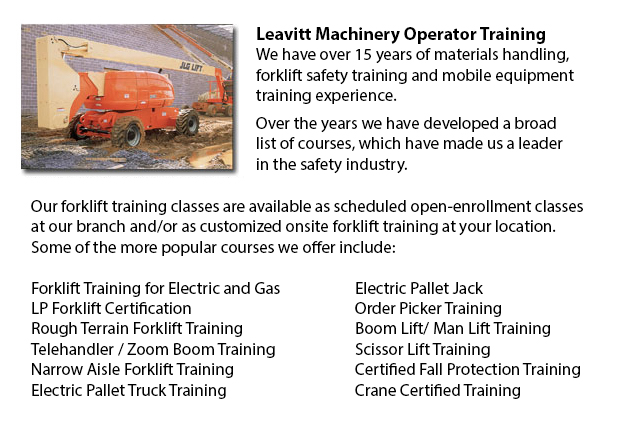
St Catharines Aerial Boom Lift Training - Aerial Boom Lift Training is needed for anybody who supervises, operates or works near boom lifts. This kind of aerial lift or aerial work platform is used for lifting individuals, materials and tools in projects requiring a long reach. They are usually used to access utility lines and other above ground job-sites. There are different kinds of aerial booms lifts, like for instance extension boom lifts, cherry pickers and articulating boom lifts. There are two types of boom lift: "telescopic" and "knuckle".
Boom lift training is important and usually involves the essential safety, operations and equipment concerns. Employees are needed while working with mobile machinery to know the dangers, safe work practices and rules. Training program materials offer an introduction to the terms, applications, concepts and skills required for workers to acquire experience in operating boom lifts. The material is aimed at equipment operators, safety experts and workers.
For your business requirements, this training is adaptive, cost-effective and educational and will help your workplace become safer and more effective, allowing for higher levels of production. Less workplace accidents happen in workplaces with strict safety policies. All machine operators must be trained and evaluated. They need knowledge of existing safety standards. They should comprehend and follow rules set forth by their employer and local governing authorities.
Employers must ensure that their workers who operate aerial boom lifts get proper training in their safe use. Operator certification is required on each different type of aerial machine utilized in the workplace. Certifications are offered for articulating booms, aerial work platforms, scissor lifts, industrial forklift trucks, et cetera. Completely trained workers work more efficiently and effectively than untrained workers, who need more supervision. Right instruction and training saves resources in the long run.
The best prevention for workplace fatalities is correct training. Training could help prevent electrocutions, falls and tip overs or collapses. Other than obtaining the necessary training, workplace accidents can be better avoided by using the aerial work platforms based on the manufacturer's instructions. Allow for the combined weight of the tools, materials and the worker when adhering to load restrictions. Never override hydraulic, mechanical or electrical safety devices. Workers should be held securely inside the basket with a body harness or restraining belt with a lanyard attached. Do not move lift machine whilst workers are on the elevated platform. Employees must be careful not to position themselves between the basket rails and joists or beams in order to avoid being crushed. Energized overhead power lines should be at least 10 feet away from the lift machinery. It is suggested that employees always assume power lines and wires may be energized, even if they are down or seem to be insulated. Set the brakes and utilize wheel chocks if working on an incline.
-
St Catharines Heavy Equipment Training Schools
St Catharines Heavy Equipment Training Schools - When selecting an operator training course, there are a lot of heavy equipment training schools to choose from. To be able to ascertain the qualifications you will attain, it is very important to explo... More -
St Catharines Heavy Equipment Operator Training
St Catharines Heavy Equipment Operator Training - Heavy equipment operator training facilities that offer quality standards within the business, offering field performance work and additional machine training are really sought after training features... More -
St Catharines Forklift Training Programs
St Catharines Forklift Training Programs - Are you looking for work as a driver of a forklift? Our regulatory-compliant mobile equipment operator training offers instruction in kinds of forklifts, pre-shift check, fuel kinds and handling of fuels, an... More -
St Catharines Heavy Equipment License
St Catharines Heavy Equipment License - A heavy equipment license can be obtained by taking a certification and preparation course at a private training school or a vocational school. This license would qualify you to operate various types of heavy e... More -
St Catharines Overhead Crane Safety Training
St Catharines Overhead Crane Safety Training - Overhead crane safety training equips operators with skills and knowledge regarding crane safety precautions, accident avoidance, materials handling, and equipment and stock protection. Trainees will lea... More -
St Catharines Scissor Lift Training
St Catharines Scissor Lift Training - Scissor lifts should be operated proficiently to be able to protect the safety of the equipment and the wellbeing of others within the workplace. Operators who are skilled are trained to drive the specific type o... More -
St Catharines Telescopic Training
St Catharines Telescopic Training - Telescopic Handlers are a kind of forklift, normally known as telehandlers. This machine has been increasing in popularity due to its greater lift heights and its versatility. It is often preferred over the convent... More -
St Catharines Boom Lift Certification
St Catharines Boom Lift Certification - Utilizing elevated work platforms allow for maintenance operations and work to be carried out at elevated work heights which were otherwise unreachable. Boom Lift Certification Training educates workers about t... More

Forklift Certification St Catharines
TOLL FREE: 1-888-254-6157
St Catharines, Ontario
forkliftcertificationstcatharines.com/
Email Us
About Us


